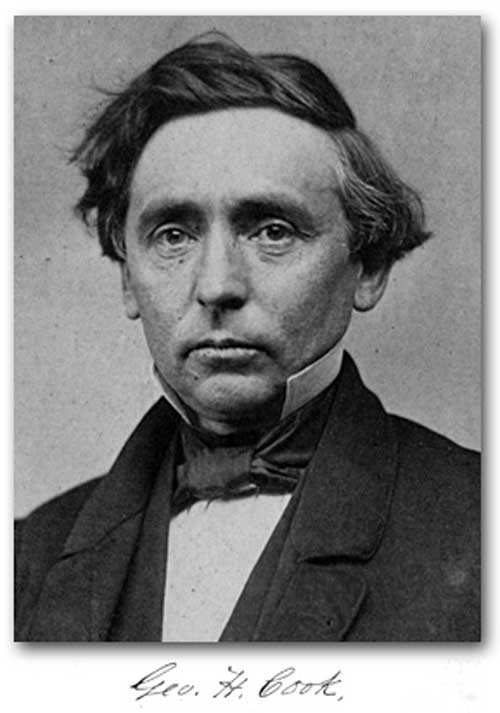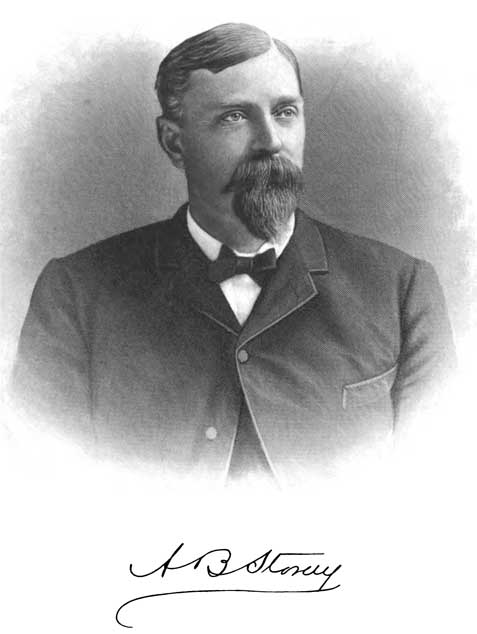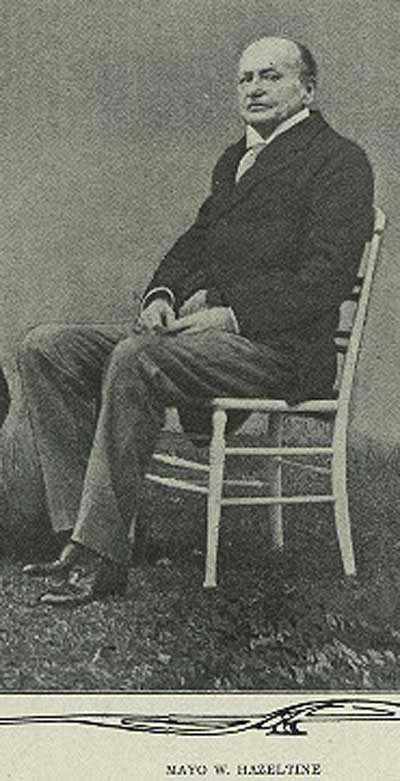Morgan Maps – Who Were the Joint Boundary Commissioners?

Dr. George Hammell Cook, State Geologist of New Jersey and Vice President of Rutgers College. Photo Courtesy of Rutgers University.
Regarding the six commissioners, I have been able to find information thus far on only five of them. Four of these five individuals appear to have been well qualified to undertake such an endeavor. The fifth was a Writer and Literary Editor. While it isn’t clear to me why a Literary Editor would be selected for such a commission, there must have been some reason for such a selection. Google searches on the remaining commissioner didn’t produce results which stand out due to him having a very common name.
By state, here is information about the six commissioners:
New Jersey
- George H. Cook of New Brunswick
- Robert C. Bacot of Jersey City
- A. B. Stoney of Keyport
George H. Cook – Professor Cook is the same Dr. George Hammell Cook that CookCollege and Cook Campus of Rutgers University was named for. Dr. Cook was the first full-time non-clerically trained faculty member at Rutgers in 1853. He was later to become the State Geologist of New Jersey and Vice President of Rutgers College – both in 1864. In 1880, he was appointed as Director of the New Jersey Agricultural Experiment Station. His update to the Geological Survey of New Jersey was to become the model for the U.S. Geological Survey. The New Jersey Agricultural Experiment Station was to become Rutgers University’s Cook Campus with Cook College renamed to the School of Environmental and Biological Sciences in 2007. Dr. Cook died on September 22, 1889 at age 71 nearly two years after serving on the Joint Boundary Commission.
Robert Cochran Bacot – Mr. Bacot was a Civil Engineer by education and had at one time been the City Surveyor of Jersey City. During his life, he was to become Registrar, Chief Engineer and Superintendent of the Jersey City Water Works, a member of the NJ State Assembly, Director of the Hudson County National Bank, and President of the Hackensack Water Company. In 1855 he produced the Topographical Map of Hudson County in which the name “West New York, New Jersey” was first used (instead of Union Township). Mr. Bacot was born in Charleston, South Carolina in 1818 and moved to Jersey City in 1838. He and his wife Mary had three daughters and four sons. Mr. Bacot died April 12, 1901 at age 83.
Click here to view Mr. Bacot’s obituary in the April 13, 1901 NY Times.
A. B. Stoney – It was hard to find information about about Mr. Stoney but we now believe A. B. Stoney was Captain Alfred Bedle Stoney. A. B. Stoney was born into a sea faring family in 1842. His grandfather Captain Joseph Stoney commanded the steamer “Wave,” which regularly sailed between Keyport and New York City starting in 1839 and his father Captain Stephen Stoney commanded the “Golden Gate” on a freight line from Matawan. At age 17, Alfred became the commander of his father’s steamer, a position he kept for six years. From 1879 to 1885, he was general manager of the Keyport Steamboat Company. In 1885 he operated his passenger steamer the “D. R. Martin” on the Delaware River between Philadelphia points on the Delaware. He started on the Keyport school board in 1873 and for a long period was its chairman. In 1883, he was elected a member of the New Jersey state legislature and was chairman of the committee on railroads and canals that year. His top political position was in 1884 when he was paid $100 and was elected Speaker of the NJ Assembly. He was said to be “an entertaining conversationalist, a genial and agreeable companion.” Captain Stoney and his wife, Anna, had two children, Alfred B. and Agatha P.
A big thank you goes to Alycia Rihacek of The Thomas Warne Museum & Library of The Madison Township Historical Society in Old Bridge Township, NJ for finding the information about Captain Stoney!
New York
- Lieut. G. C. Hanus, U.S.N.
- Mayo W. Hazeltine
- Robert Moore
Lieut. G. C. Hanus – G. C. Hanus, originally from Wisconson, graduated from the U. S. Naval Academy in 1865. He performed surveys in many locations including Alaska, Raritan Bay, Virginia and Nicaragua. A summary of his long military career, which concluded upon his retirement on June 30, 1889 at the rank of Commander can be seen by clicking here.
Following his military career, it appears as if G. C. Hanus went into the field of education. From 1902 to 1908, Commander Hanus (USN Retired) was listed as the Superintendent of the MaritimeCollege of the State University of New York. I have not found much else yet.
From my readings, clearly Lieut. G. C. Hanus U.S.N. was the most significant individual appointed to this Joint Boundary Commission. Not only had he commanded the surveying of Raritan Bay in the summer of the previous year (see the to-be-reposted write-up November 30, 2009), but he was one of the only two who attended all twelve commission meetings. He also was the only commissioner on all five of the committees appointed by the Boundary Commission. He performed the majority of the research, personally staked out the over water position of the Monument and installed the buoys in their permanent locations along the boundary. Whether his dedication and tenacity was due to his interest, his position as a Navy officer, or his ability to be totally dedicated to this task since he was a Navy officer (the others presumably had regular full time jobs), is unclear at this point. What is clear is that Lieut. Hanus’ work in 1886 & 1887 continues to serve the residents of New Jersey and New York some 123 years later.
Mayo Williamson Hazeltine – Born in New England in 1841, studied at Harvard and took a postgraduate course at Oxford. Was Literary Editor at the New York Sun Newspaper. He was twice a candidate for the House of Representatives, once for Staten Island, New York and once for a district in New Jersey. By 1899 Mr. Hazeltine was producing about 15,000 words weekly for book reviews for the New York Sun. Note that this would have required for him to have an immense amount of preparation including three to four days worth of reading for six to ten hours per day followed by a number of days dictating to a stenographer. He appears to have often added to previous authors’ works by writing supplementary chapters of recent events on the topic. He also appeared to be an author and editor as well. Mr. Hazeltine is listed as having died in 1909.
Here is a partial list of some of his work:
Wrote supplemental chapter(s) covering recent events:
- Japan (1900) Walter Dickson.
- China (1901). Demetrius Charles Boulger.
- France. M. Guizot and Madame Guizot deWitt.
- Scotland (1901). Sir Walter Scott.
Edited:
- Orations from Homer to William McKinley (1902) – Illustrated in 25 volumes.
- Masterpieces of Eloquence. Famous orations of world leaders from early Greece to the present time (1900).
Authored:
- Charles Darwin. His Place in Modern Science.
- Chats About Books. Poets and Novelists (1883).
- The United States and the Late Lord Salisbury (1903).
- British and American Education; The Universities of the Two Countries Compared (1880).
- “What Is to Be Done with Cuba?” The North American Review, vol. 167, issue 502 (September 1898).
Robert Moore – no additional information has thus far been found.
Originally posted on April 4, 2010.


Prof. Cook also served on the New Jersey Boundary Commission of 1888-90. This Commision was tasked with laying the boundary line between NJ and NY in the Hudson River, Bay of New York, Kill van Kull and the Arthur Kill. His death occurred during his service on this commission. He was replaced by E.A. Stevens, an engineer and son of the founder of Stevens Institute (now, Stevens Institute of Technology) in Hoboken.
Check out theforgottenline.com
The report of the 1890 Commission can be found here: https://archive.org/details/reportproceeding01newj
The 1887 Commission report: https://archive.org/details/reportproceeding00njer